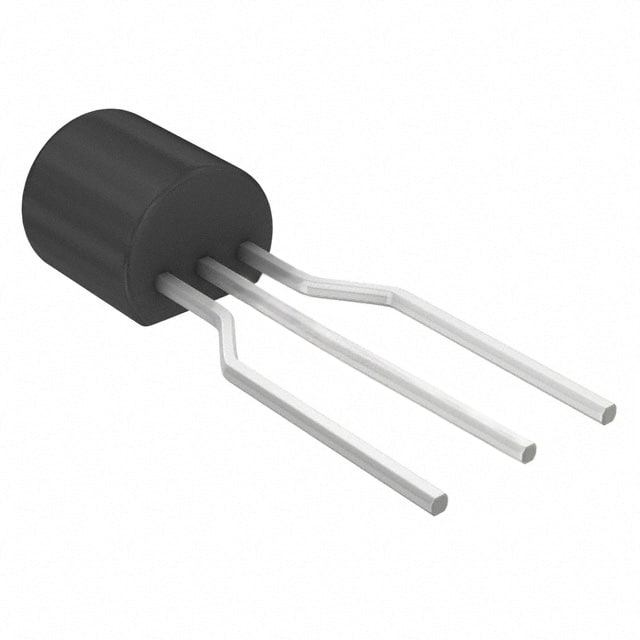BC548ATA - Encyclopedia Entry
Product Overview
Category: Transistor
Use: Amplification and switching in electronic circuits
Characteristics: Small signal NPN bipolar junction transistor, low power, high voltage, and moderate current capability
Package: TO-92
Essence: BC548ATA is a versatile transistor suitable for various electronic applications.
Packaging/Quantity: Typically available in reels of 2000 units.
Specifications
- Maximum Collector-Emitter Voltage (Vce): 30V
- Maximum Collector-Base Voltage (Vcb): 30V
- Maximum Emitter-Base Voltage (Veb): 5V
- Collector Current (Ic): 100mA
- Power Dissipation (Pd): 500mW
- Transition Frequency (ft): 150MHz
- Hfe (DC Current Gain): 110-800
Detailed Pin Configuration
- Emitter (E)
- Base (B)
- Collector (C)
Functional Features
- Suitable for audio amplification and signal processing circuits
- Can be used as a switch in digital logic circuits
- Low noise and distortion characteristics
Advantages and Disadvantages
Advantages: - Versatile and widely used in various electronic applications - High transition frequency allows for use in high-frequency circuits - Low cost and readily available
Disadvantages: - Limited power handling capability - Relatively low current gain compared to some alternative models
Working Principles
BC548ATA operates based on the principles of bipolar junction transistors. In amplification applications, small variations in the base current control the larger collector current, allowing for signal amplification. In switching applications, the transistor can be turned on or off by controlling the base current, allowing it to act as a digital switch.
Detailed Application Field Plans
BC548ATA finds extensive use in: - Audio amplifier circuits - Signal processing circuits - Oscillator circuits - Digital logic circuits
Detailed and Complete Alternative Models
Some alternative models to BC548ATA include: - 2N3904 - BC547 - 2SC945 - 2N2222
This diverse range of alternative models provides flexibility in design and application, allowing engineers to select the most suitable transistor for their specific requirements.
This comprehensive entry provides an in-depth understanding of BC548ATA, covering its specifications, functional features, advantages, disadvantages, working principles, application field plans, and alternative models.
قم بإدراج 10 أسئلة وإجابات شائعة تتعلق بتطبيق BC548ATA في الحلول التقنية
What is the BC548ATA transistor used for?
- The BC548ATA transistor is commonly used for amplification and switching applications in electronic circuits.
What are the key specifications of the BC548ATA transistor?
- The BC548ATA is a general-purpose NPN bipolar junction transistor with a maximum collector current of 500mA, a maximum collector-emitter voltage of 30V, and a maximum power dissipation of 625mW.
Can the BC548ATA be used for audio amplifier circuits?
- Yes, the BC548ATA is suitable for small signal amplification in audio amplifier circuits and other low-power applications.
What are the typical operating conditions for the BC548ATA?
- The BC548ATA transistor typically operates within a temperature range of -55°C to 150°C and is designed for use in low to medium frequency applications.
How can I identify the pinout of the BC548ATA transistor?
- The pinout of the BC548ATA transistor is typically identified as the emitter (E), base (B), and collector (C) pins, with the flat side facing towards you and the pins down.
Is the BC548ATA suitable for use in high-frequency circuits?
- The BC548ATA is not specifically designed for high-frequency applications, but it can be used in low to medium frequency circuits with appropriate design considerations.
What are some common alternatives to the BC548ATA transistor?
- Common alternatives to the BC548ATA include the 2N3904, 2N2222, and PN2222 transistors, which have similar characteristics and can be used in similar applications.
Can the BC548ATA be used in a Darlington pair configuration?
- Yes, the BC548ATA can be used in a Darlington pair configuration to achieve higher current gain and lower saturation voltage in certain applications.
What are the typical gain characteristics of the BC548ATA transistor?
- The BC548ATA transistor has a typical DC current gain (hFE) ranging from 110 to 800, depending on the operating conditions and biasing.
Are there any specific precautions to consider when using the BC548ATA in technical solutions?
- It's important to ensure proper biasing, avoid exceeding the maximum ratings, and consider thermal management to prevent overheating in high-power applications.


